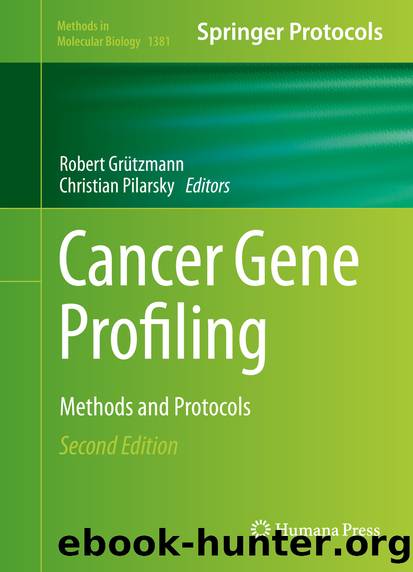Cancer Gene Profiling by Robert Grützmann & Christian Pilarsky

Author:Robert Grützmann & Christian Pilarsky
Language: eng
Format: epub
Publisher: Springer New York, New York, NY
6 Exosomes , Target Selection, and Exosome Uptake
Exosomes are the most potent intercellular communicators. This discovery has revolutionized many aspects of biological sciences and is expected to bring a major breakthrough in therapy, including cancer . The power of exosomes relies on their ubiquitous presence, their particular protein profile, their equipment with mRNA and miRNA and their most efficient transfer in target cells. Information on the latter aspect, the uptake by target cells and the exosomes’ target cell selection are two prerequisites for clinical translation.
Exosomes are taken up by target cells. Thus, exosomal mouse mRNA and miRNA was recovered in human cells after co-culture [25] and luciferin-loaded exosomes induced bioluminescence in luciferase expressing cells [167], which implies merging of the exosomal cytosol with the target cell cytoplasm through membrane fusion either at the plasma membrane or after uptake. The most common method for detecting exosomes uptake uses lipophilic fluorescent dyes, like PKH67, PKH26, rhodamine B, DiI, and DiD. Alternatively, chemical compounds, like CFSE and CFDA can be used, which become fluorescent in the cytoplasm after esterification [168, 169]. To differentiate between binding and uptake, the target cell can be stripped by acid treatment or trypsin [170]. The latter procedures confirm exosome internalization. Exosome uptake can also be visualized by fusing an abundant exosomal protein with a fluorescent tag. All these methods have some drawbacks, like dye leakiness or exosome clumping or altered tagged protein configuration. Nonetheless there is overwhelming evidence that exosomes are, indeed, taken up. However, the route of uptake is still disputed.
There is evidence for clathrin-mediated endocytosis, GEM-supported endocytosis, phagocytosis, macropinocytosis and membrane fusion , which possibly are not mutually exclusive [168, 171–175]. The mode of exosome uptake depends in part on the protein signature of the exosomes and the target cell as well as on membrane subdomains of the target cell that may change with the target cells activation state. Accordingly, blocking antibodies and reagents that modulate targeted proteins or disturb membrane microdomains are commonly used to obtain hints toward the underlying mechanism. To give a few examples: treatment with chemicals providing evidence for endocytosis have been heparin that targets heparansulfate proteoglycans and asialofetuin, which targets Galectin 5, or cytochalasinB and D and latrunculin that destroy the actin cytoskeleton [167, 176–179]. Caveolin- and clathrin-dependent uptake was suggested by dynamin and dynamin-2 inhibitors [176, 177]; the efficacy of cholesterol depletion by methyl-β-cyclodextrin, filipin or other chemicals argues for lipid raft-mediated endocytosis [35, 44, 167] (Fig. 3). Antibody blocking studies provided evidence for the engagement of tetraspanins, likely via tetraspanin-associated transmembrane molecules, e.g. integrins that bind to ICAMs on target cells [35, 180, 181]. In fact, the engagement of integrins, like CD11a binding to ICAM-1 [182] has been amply demonstrated though mostly without evaluating the association with tetraspanins. The T-cell receptor complex in association with accessory molecules binds to MHC complexes on DC exosomes [183, 184]. Blocking studies by chemicals and/or antibodies can be confirmed by a transient knockdown of the molecule suggested to be engaged in exosome uptake.
Download
This site does not store any files on its server. We only index and link to content provided by other sites. Please contact the content providers to delete copyright contents if any and email us, we'll remove relevant links or contents immediately.
| Automotive | Engineering |
| Transportation |
Whiskies Galore by Ian Buxton(41935)
Introduction to Aircraft Design (Cambridge Aerospace Series) by John P. Fielding(33085)
Small Unmanned Fixed-wing Aircraft Design by Andrew J. Keane Andras Sobester James P. Scanlan & András Sóbester & James P. Scanlan(32763)
Craft Beer for the Homebrewer by Michael Agnew(18194)
Turbulence by E. J. Noyes(7977)
The Complete Stick Figure Physics Tutorials by Allen Sarah(7334)
Kaplan MCAT General Chemistry Review by Kaplan(6897)
The Thirst by Nesbo Jo(6877)
Bad Blood by John Carreyrou(6581)
Modelling of Convective Heat and Mass Transfer in Rotating Flows by Igor V. Shevchuk(6406)
Learning SQL by Alan Beaulieu(6235)
Weapons of Math Destruction by Cathy O'Neil(6206)
Man-made Catastrophes and Risk Information Concealment by Dmitry Chernov & Didier Sornette(5951)
Digital Minimalism by Cal Newport;(5699)
Life 3.0: Being Human in the Age of Artificial Intelligence by Tegmark Max(5506)
iGen by Jean M. Twenge(5384)
Secrets of Antigravity Propulsion: Tesla, UFOs, and Classified Aerospace Technology by Ph.D. Paul A. Laviolette(5330)
Design of Trajectory Optimization Approach for Space Maneuver Vehicle Skip Entry Problems by Runqi Chai & Al Savvaris & Antonios Tsourdos & Senchun Chai(5036)
Pale Blue Dot by Carl Sagan(4949)
